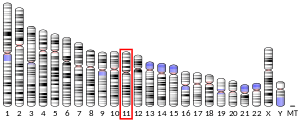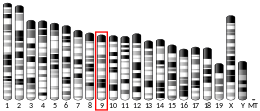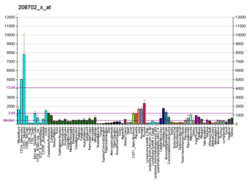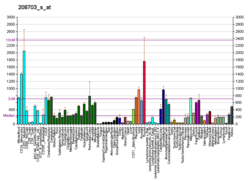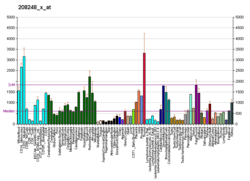APLP2
Amyloid-like protein 2, also known as APLP2, is a protein that in humans is encoded by the APLP2 gene.[5][6] APLP2 along with APLP1 are important modulators of glucose and insulin homeostasis.[7]
Gene location
The human APLP2 gene is located on the long (q) arm of chromosome 11 at region 2 band 4, from base pair 130, 069, 821 to base pair 130, 144, 811 (GRCh38.p7).[5]
Protein structure
APLP2 consists of 763 amino acids, with 31 amino acids making up the signal peptide and 732 amino acids making up the chain of the protein.[8]
Extracellular domain
The extracellular domain (residues 32-692) contains the E1 domain, E2 domain, and BPTI/Kunitz inhibitor domain.[8][9] The E1 domain contains two independent folding units, the growth factor-like domain (GFLD) and the copper-binding domain (CuBD).[9] GFLD has a highly charged basic surface and a highly flexible region consisting of an N-terminal loop formed by a disulphide bridge.[9] CuBD consists of an alpha-helix that is tightly packed on a triple-stranded beta-sheet.[9]
The E2 domain is the largest subdomain of APLP2 and consists of six alpha-helixes.[9] The N-terminal double stranded coiled coil structure of the first monomer of E2 packs against the C-terminal triple stranded coiled coil structure of the second monomer.[9]
The BPTI/Kunitz inhibitor domain (residues 306-364)[8] is ‘Cys-rich’ and is capable of inhibiting several proteases.[10]
The ectodomain of APLP2 is dimeric and contains multiple binding sites for metal ions and components of the extracellular matrix.[9] These bindings site can bind copper, zinc, collagen and heparan sulfate.[9]
Transmembrane region
The transmembrane region of APLP2 (residues 693-716) is helical in structure.[8]
Cytoplasmic domain
The cytoplasmic domain (resides 717-763)[8] contains a YENPTY sequence suggesting a duel function of the domain.[9] The NPxY motif can function as a signal for endocytosis or the sequence can function to mediate binding of various interactive partners.[9]
Function
APLP2 associates with antigen presentation molecules like MHC class I molecules and regulates their surface expression by enhancing endocytosis.[11][12]
APLP1 and APLP2 double knockout mice display hypoglycemia and hyperinsulinemia indicating that these two proteins are important modulators of glucose and insulin homeostasis.[7] APLP2 has also been shown to regulate development of the brain by regulating migration and differentiation of neural stem cells.[13]
Double mice knock outs of APLP2 and its homologues, APP and APLP1 have shown a strong indication that APLP2 has the key physiological role among the family members.[14] APLP2/APP double knock out mice and APLP2/APLP1 double knock out mice each show a lethal phenotype (postnatal day 1), whereas APLP1/APP double knock out mice are apparently normal, demonstrating the importance of the APLP2 protein.[14]
APLP2 plays a role in synaptic plasticity, functioning to promote neurite outgrowth, neural cell migration and copper homeostasis.[14] Analysing the neurons and networks of APP/APLP2 double knock out mice using stem cell-derived neurons and slice cultures, shows deficient excitatory synaptic transmission in this genotype.[15] Moreover, APLP2 together with APP has been demonstrated to exhibit presynaptic and postsynaptic functions in synaptogenesis and maintenance of synapses.[16]
APLP2 has shown to act as a cargo receptor in axonal transport for intact proteins.[17]
Clinical significance
APLP2 is part of a family of mammalian membrane proteins along with APLP1 and amyloid precursor protein (APP).[18] Since APP plays a key role in the molecular pathology of Alzheimer’s disease (AD), it has been hypothesized that APLP2 also plays a role in AD pathogenesis.[19] The amyloid β peptide (Aβ) that is present on APP has been shown to cause neurotoxic effects leading to AD.[20] Although the Aβ sequence is not present on APLP2, it has been suggested that APLP2 and APP share a functional redundancy whereby both proteins interplay with one another to exhibit physiological functions to do with synapse formation.[19]
Interactions
APLP2 has been shown to interact with APBB1.[21][22]
References
- GRCh38: Ensembl release 89: ENSG00000084234 - Ensembl, May 2017
- GRCm38: Ensembl release 89: ENSMUSG00000031996 - Ensembl, May 2017
- "Human PubMed Reference:". National Center for Biotechnology Information, U.S. National Library of Medicine.
- "Mouse PubMed Reference:". National Center for Biotechnology Information, U.S. National Library of Medicine.
- "Entrez Gene: APLP2 Amyloid beta (A4) precursor-like protein 2".
- Leach R, Ko M, Krawetz SA (1999). "Assignment of amyloid-precursor-like protein 2 gene (APLP2) to 11q24 by fluorescent in situ hybridization". Cytogenetics and Cell Genetics. 87 (3–4): 215–6. doi:10.1159/000015472. PMID 10702673.
- Needham BE, Wlodek ME, Ciccotosto GD, Fam BC, Masters CL, Proietto J, Andrikopoulos S, Cappai R (June 2008). "Identification of the Alzheimer's disease amyloid precursor protein (APP) and its homologue APLP2 as essential modulators of glucose and insulin homeostasis and growth". The Journal of Pathology. 215 (2): 155–63. doi:10.1002/path.2343. PMID 18393365.
- "APLP2 - Amyloid-like protein 2 precursor - Homo sapiens (Human) - APLP2 gene & protein". www.uniprot.org. Retrieved 2016-10-03.
- Kaden D, Munter LM, Reif B, Multhaup G (April 2012). "The amyloid precursor protein and its homologues: structural and functional aspects of native and pathogenic oligomerization". European Journal of Cell Biology. 91 (4): 234–9. doi:10.1016/j.ejcb.2011.01.017. PMID 21459473.
- Petersen LC, Bjørn SE, Norris F, Norris K, Sprecher C, Foster DC (January 1994). "Expression, purification and characterization of a Kunitz-type protease inhibitor domain from human amyloid precursor protein homolog". FEBS Letters. 338 (1): 53–7. doi:10.1016/0014-5793(94)80115-0. PMID 8307156.
- Tuli A, Sharma M, Naslavsky N, Caplan S, Solheim JC (June 2008). "Specificity of amyloid precursor-like protein 2 interactions with MHC class I molecules". Immunogenetics. 60 (6): 303–13. doi:10.1007/s00251-008-0296-0. PMC 2683759. PMID 18452037.
- Tuli A, Sharma M, McIlhaney MM, Talmadge JE, Naslavsky N, Caplan S, Solheim JC (August 2008). "Amyloid precursor-like protein 2 increases the endocytosis, instability, and turnover of the H2-K(d) MHC class I molecule". Journal of Immunology. 181 (3): 1978–87. doi:10.4049/jimmunol.181.3.1978. PMC 2607064. PMID 18641335.
- Shariati SA, Lau P, Hassan BA, Müller U, Dotti CG, De Strooper B, Gärtner A (March 2013). "APLP2 regulates neuronal stem cell differentiation during cortical development". Journal of Cell Science. 126 (Pt 5): 1268–77. doi:10.1242/jcs.122440. PMID 23345401.
- Walsh DM, Minogue AM, Sala Frigerio C, Fadeeva JV, Wasco W, Selkoe DJ (April 2007). "The APP family of proteins: similarities and differences". Biochemical Society Transactions. 35 (Pt 2): 416–20. doi:10.1042/BST0350416. PMID 17371289.
- Schrenk-Siemens K, Perez-Alcala S, Richter J, Lacroix E, Rahuel J, Korte M, Müller U, Barde YA, Bibel M (August 2008). "Embryonic stem cell-derived neurons as a cellular system to study gene function: lack of amyloid precursor proteins APP and APLP2 leads to defective synaptic transmission". Stem Cells. 26 (8): 2153–63. doi:10.1634/stemcells.2008-0010. PMID 18535156.
- Wang Z, Wang B, Yang L, Guo Q, Aithmitti N, Songyang Z, Zheng H (September 2009). "Presynaptic and postsynaptic interaction of the amyloid precursor protein promotes peripheral and central synaptogenesis". The Journal of Neuroscience. 29 (35): 10788–801. doi:10.1523/JNEUROSCI.2132-09.2009. PMC 2757256. PMID 19726636.
- Müller U, Kins S (2002). "APP on the move". Trends in Molecular Medicine. 8 (4): 152–5. doi:10.1016/S1471-4914(02)02320-1. PMID 11927267.
- Korte M, Herrmann U, Zhang X, Draguhn A (April 2012). "The role of APP and APLP for synaptic transmission, plasticity, and network function: lessons from genetic mouse models". Experimental Brain Research. 217 (3–4): 435–40. doi:10.1007/s00221-011-2894-6. PMID 22006270.
- Midthune B, Tyan SH, Walsh JJ, Sarsoza F, Eggert S, Hof PR, Dickstein DL, Koo EH (April 2012). "Deletion of the amyloid precursor-like protein 2 (APLP2) does not affect hippocampal neuron morphology or function". Molecular and Cellular Neurosciences. 49 (4): 448–55. doi:10.1016/j.mcn.2012.02.001. PMC 3348437. PMID 22353605.
- Hardy J, Selkoe DJ (July 2002). "The amyloid hypothesis of Alzheimer's disease: progress and problems on the road to therapeutics". Science. 297 (5580): 353–6. doi:10.1126/science.1072994. PMID 12130773.
- Guénette SY, Chen J, Jondro PD, Tanzi RE (October 1996). "Association of a novel human FE65-like protein with the cytoplasmic domain of the beta-amyloid precursor protein". Proceedings of the National Academy of Sciences of the United States of America. 93 (20): 10832–7. doi:10.1073/pnas.93.20.10832. PMC 38241. PMID 8855266.
- Tanahashi H, Tabira T (February 1999). "Molecular cloning of human Fe65L2 and its interaction with the Alzheimer's beta-amyloid precursor protein". Neuroscience Letters. 261 (3): 143–6. doi:10.1016/S0304-3940(98)00995-1. PMID 10081969.
External links
- Human APLP2 genome location and APLP2 gene details page in the UCSC Genome Browser.
